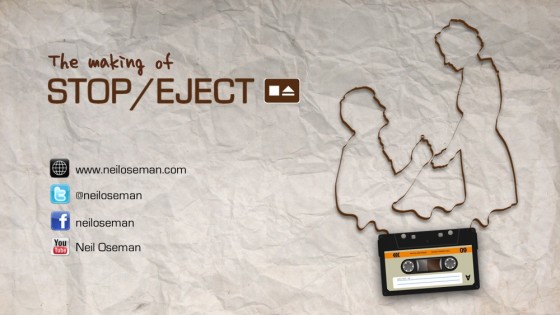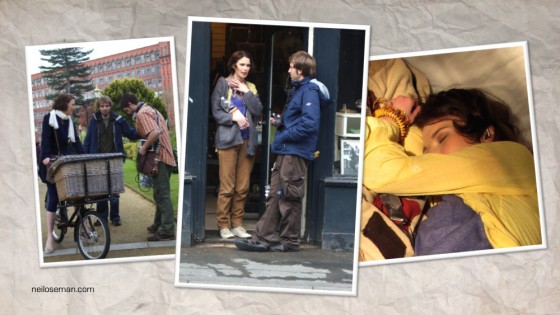
Recently I gave a talk on the whole process of making Stop/Eject to CEMRIAC, the Central and East Midlands Region of the Institute of Amateur Cinematographers. I was subsequently asked to summarise the talk for the organisation’s newsletter, so I thought I’d share that summary with you today. Please get in touch if you’re interested in me giving this talk at your event.
Stop/Eject is a 17 minute fantasy drama currently in the latter stages of postproduction. It’s the story of a young woman who, following the sudden death of her husband, discovers a mysterious old tape recorder that can stop and rewind time. As the co-writer, director and cinematographer of Stop/Eject, I was able to take the CEMRIAC audience through the entire process of making the film, with plenty of behind-the-scenes clips and photographs to illustrate the creative journey.
I began by discussing crowd-funding, the method by which myself and producer Sophie Black financed Stop/Eject, whereby a large number of people each contribute relatively small amounts of money via a website. I looked at the various things to consider when launching a crowd-funding campaign: selecting a suitable “platform” website, deciding on a target and duration for the campaign, creating a pitch video, choosing what rewards to offer sponsors, and promoting the campaign. I explained how, with the liberal use of social media and emails, and a boost courtesy of a report on the BBC’s Midlands Today, Stop/Eject reached its £2,000 funding target.
Moving on to preproduction, I gave some advice on finding locations and gathering a cast and crew together. The maxim “if you don’t ask you won’t get” is an excellent one to remember here. I explained how Stop/Eject floundered a few weeks before production after several key people pulled out, but Sophie secured a new lead actress at the eleventh hour in the form of Georgina Sherrington – a former child actress who starred in a popular ITV series – simply by having the nerve to ring around agents.
After some brief discussion of scheduling the shoot, I turned to the subject of production design, explaining how visual themes and a restricted colour palette can help your sets, props and costumes have a sense of consistency and aid story-telling.
I then showed the audience the storyboards for a key scene, elucidating the reasons behind my choice of shots, before screening behind-the-scenes footage of those shots being captured during production. Further behind-the-scenes clips demonstrated some of the challenges of filming Stop/Eject, including a scene on a weir that became treacherous after heavy rains flooded it. I discussed the use of a Canon 600D DSLR to shoot the movie and the delicacies of directing strongly emotional scenes.
Next I talked about lighting, revealing how Stop/Eject was lit with a combination of standard film lamps like redheads, and less conventional sources like camping lights and halogen work lamps. An exploration of three scenes set in the same room showed how different looks can be created through lighting.
Following a quick look at the costs of production and preproduction, I moved on to discuss editing. Returning to the scene earlier viewed in storyboard form, I screened several different iterations of the edit to show how the scene evolved to become narratively clearer as well as better paced. After a look at some of the work which is currently going into Stop/Eject’s visual effects, I concluded the presentation by screening the first five minutes of the film in its present form.
